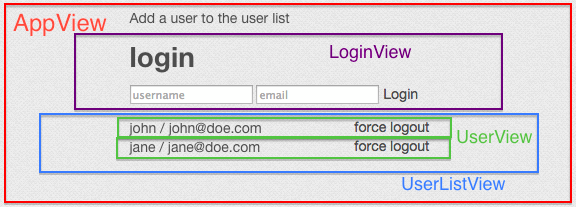Rendering Backbone (Sub)View
When learning backbone.js (i’m a novice by the way), at first, I was actually having a hard time to grasp the backbone view. Especially how the best practice to render the view and build a rather complex view consists of several subviews. And then, magically I came accross Ian Storm Taylor’s post about his experience on dealing with backbone subview. At first I didn’t quiet understand well about the post until I found a thread on stackoverflow, which was started by Ian Storm Taylor.
Based on the posts, I created a simple case study to better understand how it works. The requirements were to list pairs of username and email input by users. So at first I created the view as listed below:
<div id="application">
<p>Add a user to the user list</p>
<div id="login"></div>
<ul id="online-users"></ul>
</div>
<script id="login-template" type="text/template">
<h1> login </h1>
<input id="username" type="text" placeholder="username" />
<input id = "email" type = "text" placeholder = "email" />
<button id = "button-login" type = "button"> Login </button>
</script>
<script id="userlist-template" type="text/template">
<li>
<span><%= username %> / <%= email %></span>
<button id = "force-logout">force logout</button>
</li>
</script>
To better visualize, lets see this picture:

The outer container is #application and inside it there are
two other sub-containers #login and #online-users. Each container
or sub-container is represented in a separated view: AppView, LoginView
and UserListView respectively. To make it
nicely structured, the UserListView has a sub-view
called UserView that renders each pair of username and email
handles of the button clicked event.
there is an exception for the last view where the view is
created for each username-password pair then appended in
the container #online-users.
Now let’s get to the code.
app.AppView = Backbone.View.extend({
el: '#application',
initialize: function () {
this.users = new app.UserList();
this.loginView = new app.LoginView();
this.userListView = new app.UserListView( { collection: this.users } );
this.listenTo(this.loginView, 'login', this.login);
},
render: function () {
this.loginView.setElement(this.$('#login')).render();
this.userListView.setElement(this.$('#online-users')).render();
},
/* ... */
login: function (user) {
this.users.create( user );
}
});
app.LoginView = Backbone.View.extend({
template: _.template($('#login-template').html()),
events: {
'click #button-login': 'login'
},
render: function () {
this.$el.html(this.template());
},
login: function () {
// login logic
},
/* ... */
});
Here, the most important thing to connect Backbone view to
the html is the el (element) property. The el property defines to
which element the view template will be rendered, or at least in this case
study. In the AppView the el is set to #application
as the root container of the application. However, for its
sub-views, the el property is not defined in the view
definition but set dynamically using setElement method.
As Ian suggested, this is done to avoid the unbinding of
sub-views’ events when rendered more than a time.
The instantiation
of sub-views depends on how the sub-views are rendered.
LoginView and UserListView are instantiated in
the initialize method as the application only need
an instance for each of them. In contrast, UserView
is instantiated for each user (model) as it needs to
associate the button click event inside the view with
the contained model.
app.UserListView = Backbone.View.extend({
initialize: function () {
this.listenTo(this.collection, 'add', this.renderOne);
this.listenTo(this.collection, 'reset', this.renderAll);
},
render: function () {
this.renderAll();
},
renderOne: function (user) {
var view = new app.UserView( { model: user } );
this.$el.append(view.render().el);
},
renderAll: function () {
this.collection.each(this.renderOne);
}
});
app.UserView = Backbone.View.extend({
template: _.template($('#userlist-template').html()),
tagName: 'li',
events: {
'click #force-logout': 'clear'
},
initialize: function () {
this.listenTo(this.model, 'destroy', this.remove);
},
render: function () {
this.$el.html( this.template( this.model.attributes ) );
return this;
},
clear: function () {
this.model.destroy();
}
});
To make the code structured nicely, I used the html() and
append() method of Backbone view’s $el property. Some people
might use jquery’s selector $('.element') to render the html,
which I think it isn’t clean enough. Lastly, I’ve made a fiddle
about this post where you can play around. Hope this post
helps someone to understand more about backbone view.